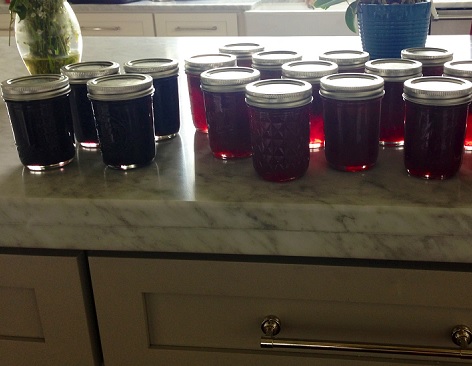
If you pick a basket full of mulberries, you’re in luck. You have a tremendous basket full of mulberries! Your basket full will look luscious, and the contents will glisten in that sun, and once you walk them from your tree to your counter, some will have started to leak. You’ll have mulberry stains on the inside of your basket, those woven wooden strips matching your own fingers, all stained and purple. On the countertop, it’ll be best if you set this leaky basket directly onto a towel, not onto the marble. The towel should be dark, maybe purple, as a white towel will only soon match those woven strips and your fingers and everyone will be stained.
Or, put the basket in your refrigerator. I’ve done this, often. But mulberries in the refrigerator don’t keep that well, at least not much better than they keep on your countertop, atop the towel. You’ll eat some mulberries, maybe in pancakes and maybe on ice cream and certainly without accompaniment. But that supply is so strong, the basket deceivingly deep, and try as you might, you cannot eat them all. Not one to waste, you seek a method to preserve. But which method is best? Clean and freeze? No. Pulverize and boil with sugar and some hoof-derived-glue? Exactly.
Mulberries are tasty, but they pose problems. When you pick a strawberry, as I picked basket fulls this summer in my smallish but remarkably prolific patch, you can pour them out onto a cutting board and you can nip with your fingers or slice with a knife, and the green umbilical top where that berry was fed easily goes away. The strawberry is tough enough to endure this, but the mulberry is not. The mulberry cannot be approached with a knife, or it’ll ink as a squid, but with delicious purple juice. The body will collapse and that glistening berry that looked so important and proud on that branch and then in that basket will be nothing but a puddle of mulberry paste. The solution is the food processor, which doesn’t discard the small, bendy stems but instead ups the fiber content of the jam and renders those stems indiscernible from the seeds and the fruit and the juice.
When the spring garden was young, it was really nice. There was a lot of freshly tilled dirt, and some meandering rows filled with the seeds that I had bought in the dead of winter. After some time and water, there were sprouts. Tender shoots of young life poking up in those crooked rows. In the spring garden, the rows were identifiable. In the now garden, the fall garden, there is no more discernment. All that is left is a sturdy blanket of weeds and thistles, and some bits of vegetable matter scattered in between. There are a few peppers and some squash, and some pumpkins and a few other things that my wife contends are Brussel Sprouts, but I contend they are nothing of the sort and are, instead, just weeds that cleverly mimic something good and edible. There are also tomatoes.
Much like the mulberries, there are too many tomatoes to eat. So we must preserve those, too. We could blanch and skin and freeze, but that’s not what we have done, nor what we may someday do. We will wash and knife off the tops and any poor looking bits, and we will bake the remainder of the flesh, skin, seeds and all. We’ll slice them in half first, and salt and pepper them, and add a bit of sugar because that makes nearly everything better. We’ll pour on some olive oil, and we’ll bake and we’ll bake, for hours and hours, until those fresh tomatoes have turned to slightly dehydrated fruit, the flavor both intensified and concentrated, the huge pan full of tomatoes having reduced in volume by a half, probably more.
Into the boiled jars they now go, the lids screwed down tightly so that when the jar and the tomato jam cools the vacuum will pull that lid tight. There are several of these jars in my cabinet now, alongside the mulberries and the strawberries and the blackberries and the mixture of the three: The Triple Berry. The tomato supply is running low, so this week I’ll take a few hours and process another 10 jars full, late into the evening my oven will do its work, baking and drying those ripe red fruits until they are ready for their respective jars. I do this with all of these fruits because I want to make these things last. I want to take what I am given and stretch the bounty. I don’t want to waste what I have, and I’d much prefer to eat jarred jam from my own garden come January than jarred jam from the Smucker family garden.
Last weekend, the weather was perfectly ripe. It was beyond ideal, as it is yet again today. This late weather is rare, and it is fleeting, and while it won’t die on the vine it will certainly be pushed away by an ornery cold front, perhaps never again to return except briefly on the heels of a brisk south wind sometime during this next month. Unlike my berries and my garden fruit, there is no preservation method capable of extending this season. This is why we must be gluttons and devour it until we are sick, and once we feel that we cannot take another moment under that warm sun, then we must devour more of it anyway. Sanitized jars cannot contain 77 degree September days, so please bask under these skies while they shine warm, because soon enough they’ll be the sort of memory that we’ll have to talk about together, and debate whether they even happened at all.
